Changes in PRIMAP-hist v2.6_final compared to v2.5.1_final for Iraq
2024-09-24
Johannes Gütschow
Change analysis for Iraq for PRIMAP-hist v2.6_final compared to v2.5.1_final
Overview over emissions by sector and gas
The following figures show the aggregate national total emissions excluding LULUCF AR6GWP100 for the country reported priority scenario. The dotted linesshow the v2.5.1_final data.
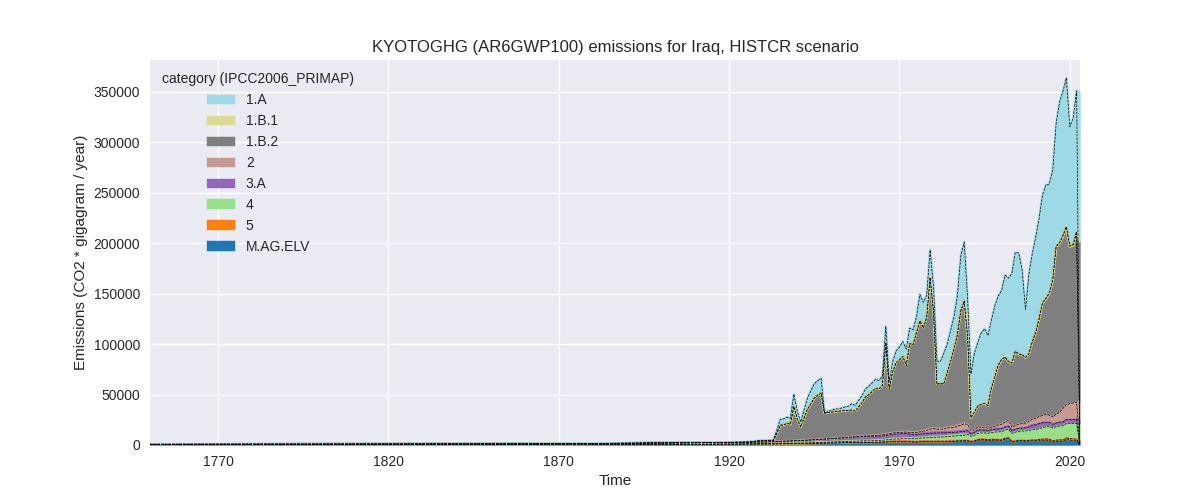

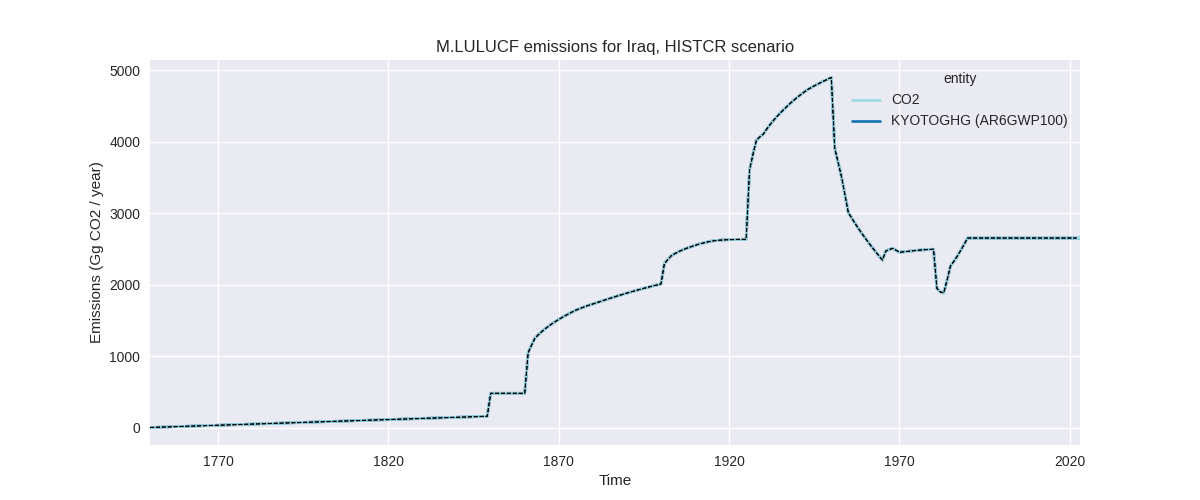
The following figures show the aggregate national total emissions excluding LULUCF AR6GWP100 for the third party priority scenario. The dotted linesshow the v2.5.1_final data.
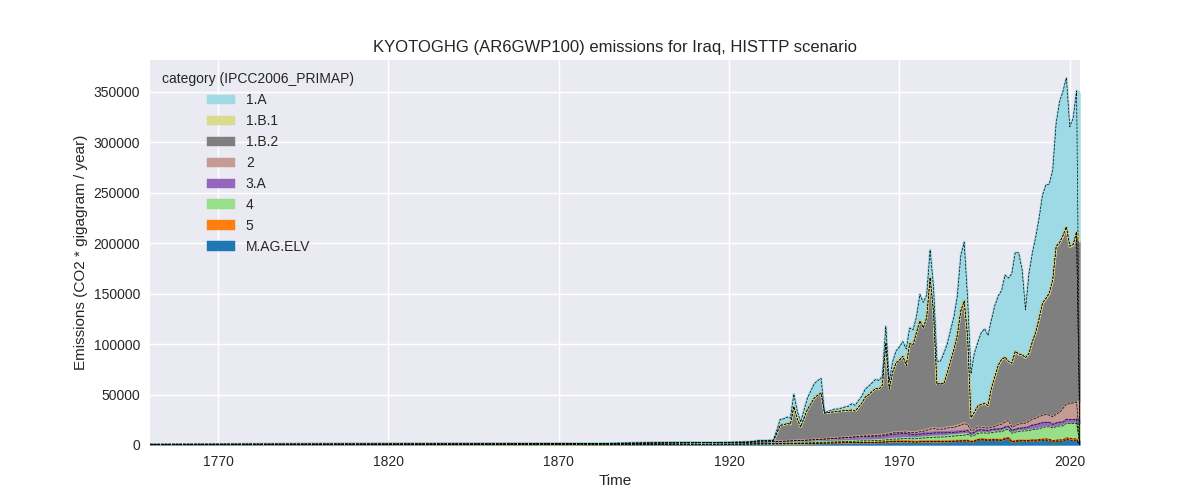

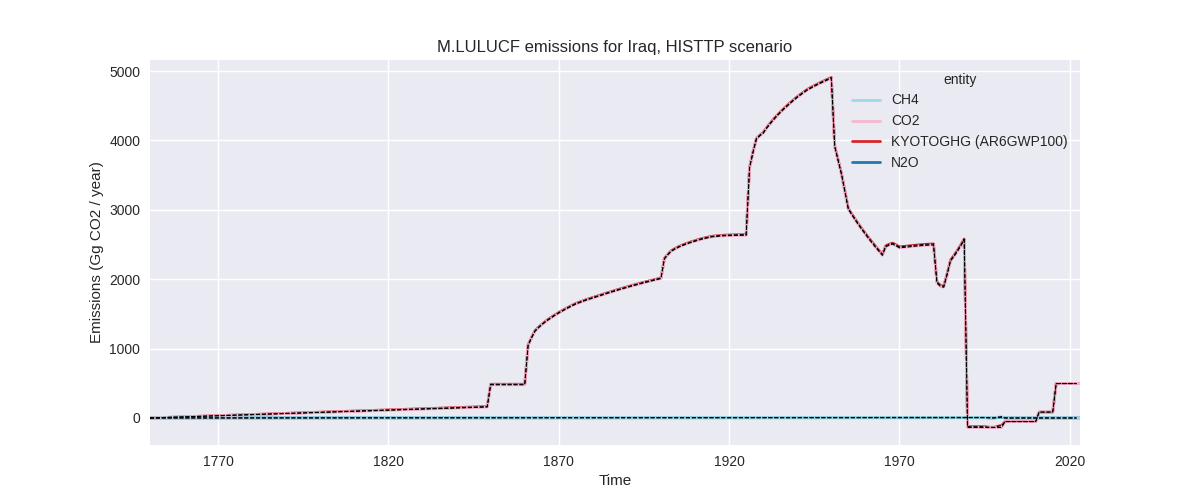
Overview over changes
In the country reported priority scenario we have the following changes for aggregate Kyoto GHG and national total emissions excluding LULUCF (M.0.EL):
- Emissions in 2022 have changed by 0.1%% (273.22 Gg CO2 / year)
- Emissions in 1990-2022 have changed by -0.1%% (-222.92 Gg CO2 / year)
In the third party priority scenario we have the following changes for aggregate Kyoto GHG and national total emissions excluding LULUCF (M.0.EL):
- Emissions in 2022 have changed by 0.1%% (273.22 Gg CO2 / year)
- Emissions in 1990-2022 have changed by -0.1%% (-222.92 Gg CO2 / year)
Most important changes per scenario and time frame
In the country reported priority scenario the following sector-gas combinations have the highest absolute impact on national total KyotoGHG (AR6GWP100) emissions in 2022 (top 5):
- 1: 5, N2O with -929.56 Gg CO2 / year (-52.5%)
- 2: 1.A, CO2 with 905.48 Gg CO2 / year (0.7%)
- 3: 4, N2O with 143.97 Gg CO2 / year (39.3%)
- 4: 4, CH4 with 121.11 Gg CO2 / year (0.8%)
- 5: 2, HFCS (AR6GWP100) with 64.65 Gg CO2 / year (1.5%)
In the country reported priority scenario the following sector-gas combinations have the highest absolute impact on national total KyotoGHG (AR6GWP100) emissions in 1990-2022 (top 5):
- 1: 5, N2O with -297.69 Gg CO2 / year (-33.7%)
- 2: 4, N2O with 68.47 Gg CO2 / year (30.3%)
- 3: 1.B.2, CO2 with -11.29 Gg CO2 / year (-0.1%)
- 4: 4, CH4 with 9.33 Gg CO2 / year (0.1%)
- 5: 2, HFCS (AR6GWP100) with 1.96 Gg CO2 / year (0.1%)
In the third party priority scenario the following sector-gas combinations have the highest absolute impact on national total KyotoGHG (AR6GWP100) emissions in 2022 (top 5):
- 1: 5, N2O with -929.56 Gg CO2 / year (-52.5%)
- 2: 1.A, CO2 with 905.48 Gg CO2 / year (0.7%)
- 3: 4, N2O with 143.97 Gg CO2 / year (39.3%)
- 4: 4, CH4 with 121.11 Gg CO2 / year (0.8%)
- 5: 2, HFCS (AR6GWP100) with 64.65 Gg CO2 / year (1.5%)
In the third party priority scenario the following sector-gas combinations have the highest absolute impact on national total KyotoGHG (AR6GWP100) emissions in 1990-2022 (top 5):
- 1: 5, N2O with -297.69 Gg CO2 / year (-33.7%)
- 2: 4, N2O with 68.47 Gg CO2 / year (30.3%)
- 3: 1.B.2, CO2 with -11.29 Gg CO2 / year (-0.1%)
- 4: 4, CH4 with 9.33 Gg CO2 / year (0.1%)
- 5: 2, HFCS (AR6GWP100) with 1.96 Gg CO2 / year (0.1%)
Notes on data changes
No country specific notes present for this changelog.
Changes by sector and gas
For each scenario and time frame the changes are displayed for all individual sectors and all individual gases. In the sector plot we use aggregate Kyoto GHGs in AR6GWP100. In the gas plot we usenational total emissions without LULUCF. ## country reported scenario
2022
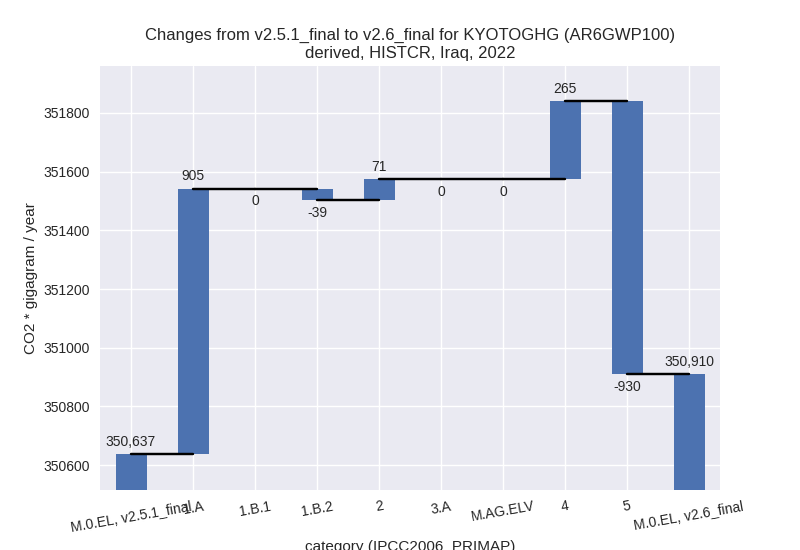

1990-2022
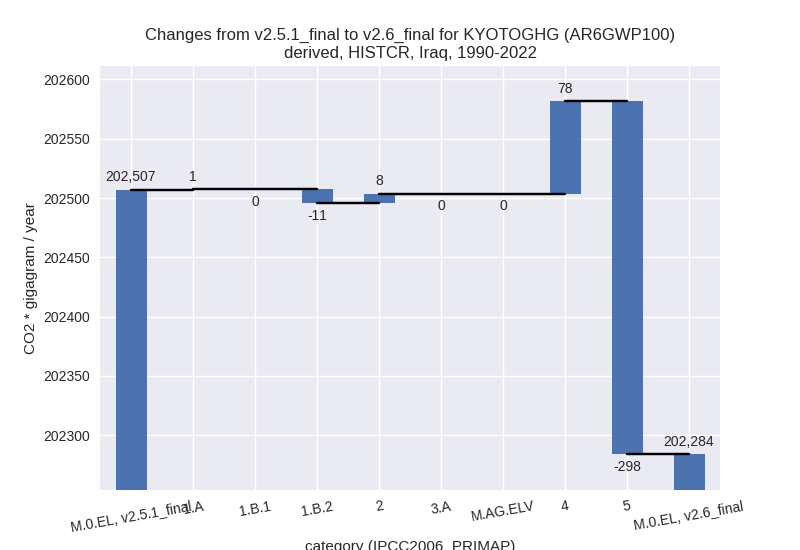
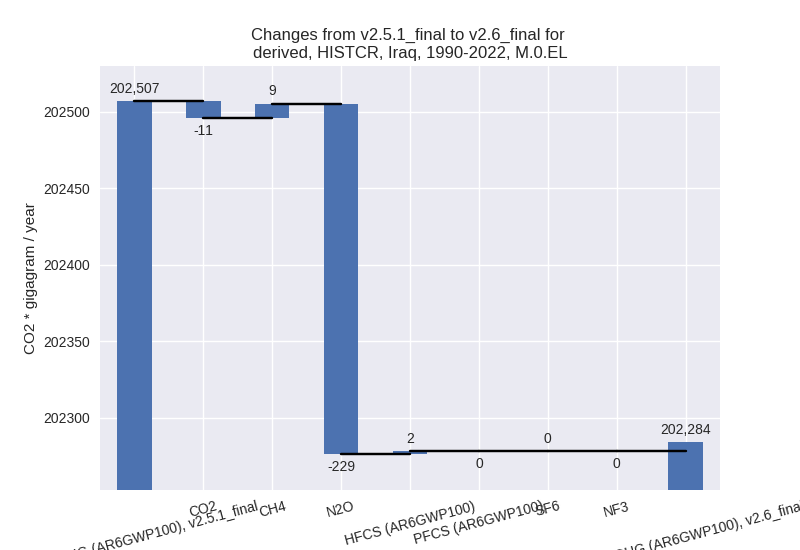
third party scenario
2022
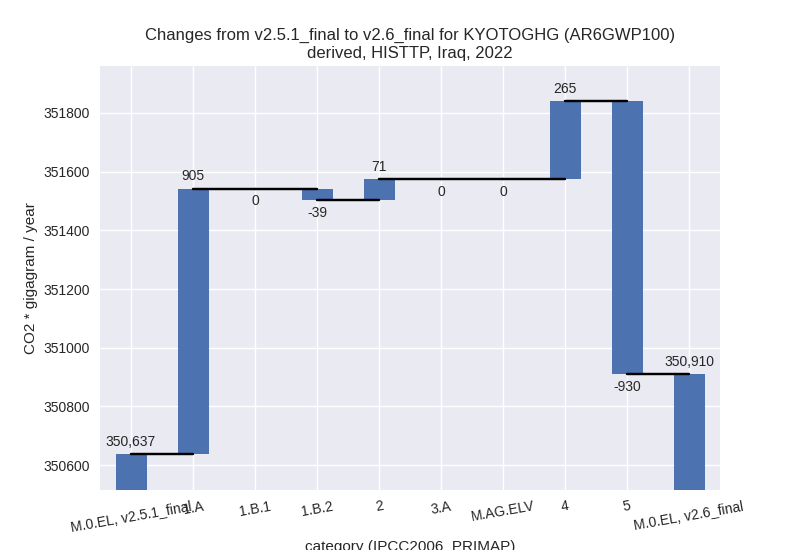
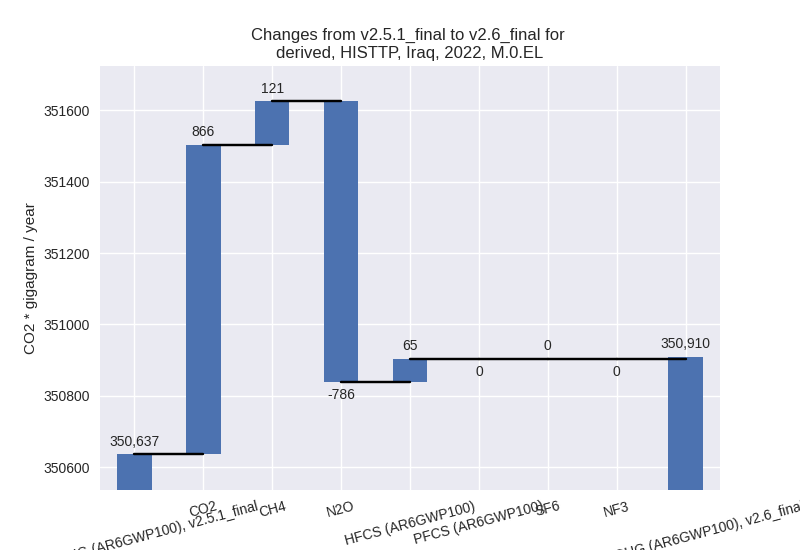
1990-2022
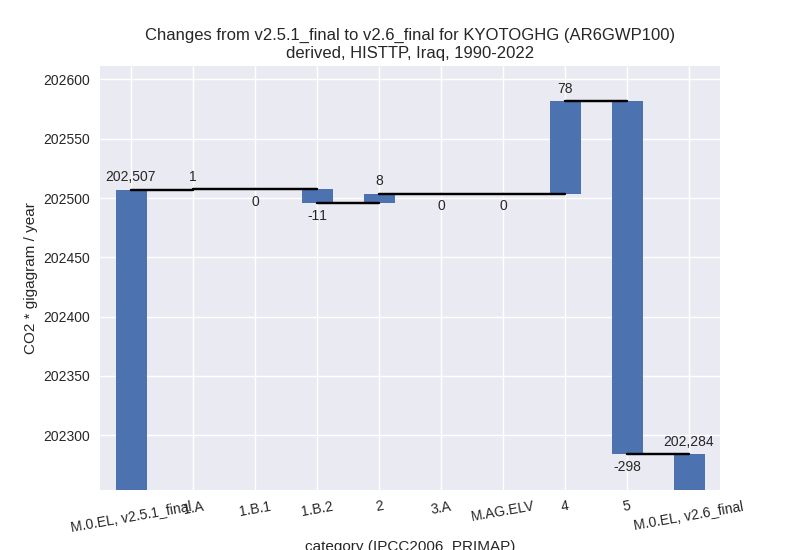
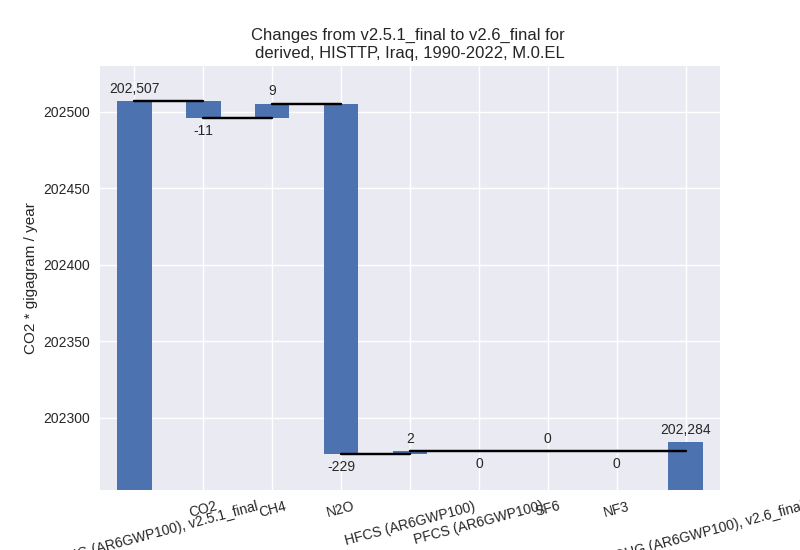
Detailed changes for the scenarios:
country reported scenario (HISTCR):
Most important changes per time frame
For 2022 the following sector-gas combinations have the highest absolute impact on national total KyotoGHG (AR6GWP100) emissions in 2022 (top 5):
- 1: 5, N2O with -929.56 Gg CO2 / year (-52.5%)
- 2: 1.A, CO2 with 905.48 Gg CO2 / year (0.7%)
- 3: 4, N2O with 143.97 Gg CO2 / year (39.3%)
- 4: 4, CH4 with 121.11 Gg CO2 / year (0.8%)
- 5: 2, HFCS (AR6GWP100) with 64.65 Gg CO2 / year (1.5%)
For 1990-2022 the following sector-gas combinations have the highest absolute impact on national total KyotoGHG (AR6GWP100) emissions in 1990-2022 (top 5):
- 1: 5, N2O with -297.69 Gg CO2 / year (-33.7%)
- 2: 4, N2O with 68.47 Gg CO2 / year (30.3%)
- 3: 1.B.2, CO2 with -11.29 Gg CO2 / year (-0.1%)
- 4: 4, CH4 with 9.33 Gg CO2 / year (0.1%)
- 5: 2, HFCS (AR6GWP100) with 1.96 Gg CO2 / year (0.1%)
Changes in the main sectors for aggregate KyotoGHG (AR6GWP100) are
- 1: Total sectoral emissions in 2022 are 308996.28 Gg CO2 / year which is 88.1% of M.0.EL emissions. 2022 Emissions have changed by 0.3% (866.42 Gg CO2 / year). 1990-2022 Emissions have changed by -0.0% (-10.77 Gg CO2 / year).
- 2: Total sectoral emissions in 2022 are 16948.42 Gg CO2 / year which is 4.8% of M.0.EL emissions. 2022 Emissions have changed by 0.4% (71.29 Gg CO2 / year). 1990-2022 Emissions have changed by 0.1% (7.75 Gg CO2 / year).
- M.AG: Total sectoral emissions in 2022 are 8212.21 Gg CO2 / year which is 2.3% of M.0.EL emissions. 2022 Emissions have changed by 0.0% (0.00 Gg CO2 / year). 1990-2022 Emissions have changed by 0.0% (0.00 Gg CO2 / year).
- 4: Total sectoral emissions in 2022 are 15913.17 Gg CO2 / year which is 4.5% of M.0.EL emissions. 2022 Emissions have changed by 1.7% (265.07 Gg CO2 / year). 1990-2022 Emissions have changed by 0.8% (77.80 Gg CO2 / year).
- 5: Total sectoral emissions in 2022 are 840.17 Gg
CO2 / year which is 0.2% of M.0.EL emissions. 2022 Emissions have
changed by -52.5% (-929.56 Gg CO2 /
year). 1990-2022 Emissions have changed by -33.7% (-297.69 Gg CO2 / year). For 2022
the changes per gas
are:
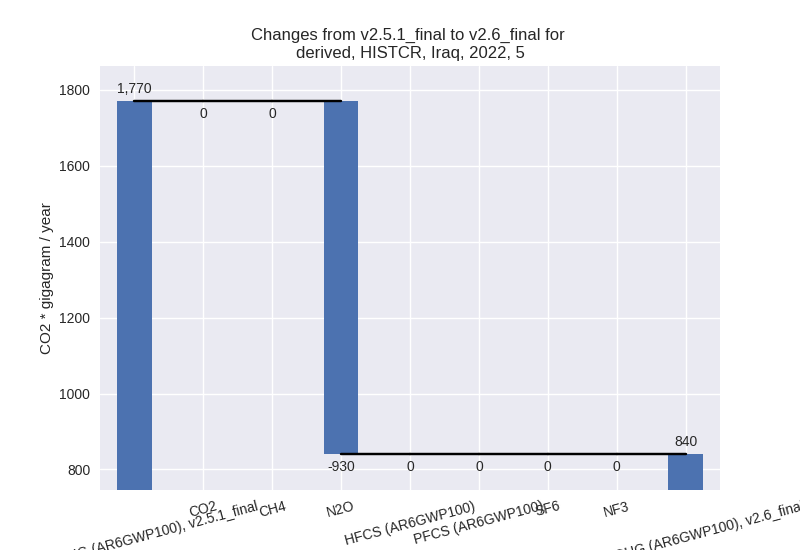
For 1990-2022 the changes per gas are: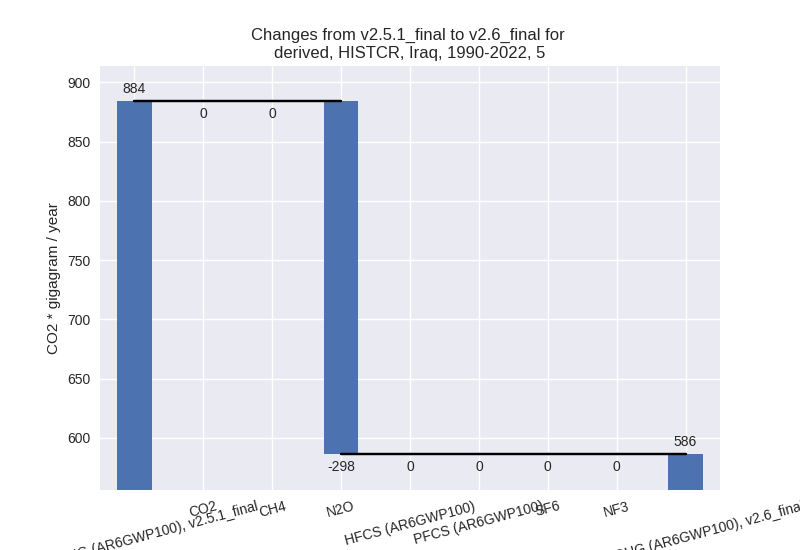
third party scenario (HISTTP):
Most important changes per time frame
For 2022 the following sector-gas combinations have the highest absolute impact on national total KyotoGHG (AR6GWP100) emissions in 2022 (top 5):
- 1: 5, N2O with -929.56 Gg CO2 / year (-52.5%)
- 2: 1.A, CO2 with 905.48 Gg CO2 / year (0.7%)
- 3: 4, N2O with 143.97 Gg CO2 / year (39.3%)
- 4: 4, CH4 with 121.11 Gg CO2 / year (0.8%)
- 5: 2, HFCS (AR6GWP100) with 64.65 Gg CO2 / year (1.5%)
For 1990-2022 the following sector-gas combinations have the highest absolute impact on national total KyotoGHG (AR6GWP100) emissions in 1990-2022 (top 5):
- 1: 5, N2O with -297.69 Gg CO2 / year (-33.7%)
- 2: 4, N2O with 68.47 Gg CO2 / year (30.3%)
- 3: 1.B.2, CO2 with -11.29 Gg CO2 / year (-0.1%)
- 4: 4, CH4 with 9.33 Gg CO2 / year (0.1%)
- 5: 2, HFCS (AR6GWP100) with 1.96 Gg CO2 / year (0.1%)
Changes in the main sectors for aggregate KyotoGHG (AR6GWP100) are
- 1: Total sectoral emissions in 2022 are 308996.28 Gg CO2 / year which is 88.1% of M.0.EL emissions. 2022 Emissions have changed by 0.3% (866.42 Gg CO2 / year). 1990-2022 Emissions have changed by -0.0% (-10.77 Gg CO2 / year).
- 2: Total sectoral emissions in 2022 are 16948.42 Gg CO2 / year which is 4.8% of M.0.EL emissions. 2022 Emissions have changed by 0.4% (71.29 Gg CO2 / year). 1990-2022 Emissions have changed by 0.1% (7.75 Gg CO2 / year).
- M.AG: Total sectoral emissions in 2022 are 8212.21 Gg CO2 / year which is 2.3% of M.0.EL emissions. 2022 Emissions have changed by 0.0% (0.00 Gg CO2 / year). 1990-2022 Emissions have changed by 0.0% (0.00 Gg CO2 / year).
- 4: Total sectoral emissions in 2022 are 15913.17 Gg CO2 / year which is 4.5% of M.0.EL emissions. 2022 Emissions have changed by 1.7% (265.07 Gg CO2 / year). 1990-2022 Emissions have changed by 0.8% (77.80 Gg CO2 / year).
- 5: Total sectoral emissions in 2022 are 840.17 Gg
CO2 / year which is 0.2% of M.0.EL emissions. 2022 Emissions have
changed by -52.5% (-929.56 Gg CO2 /
year). 1990-2022 Emissions have changed by -33.7% (-297.69 Gg CO2 / year). For 2022
the changes per gas
are:
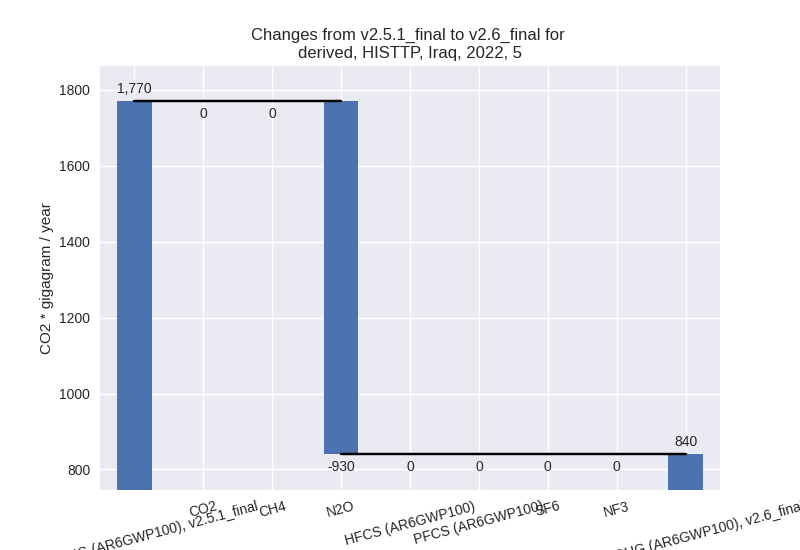
For 1990-2022 the changes per gas are: